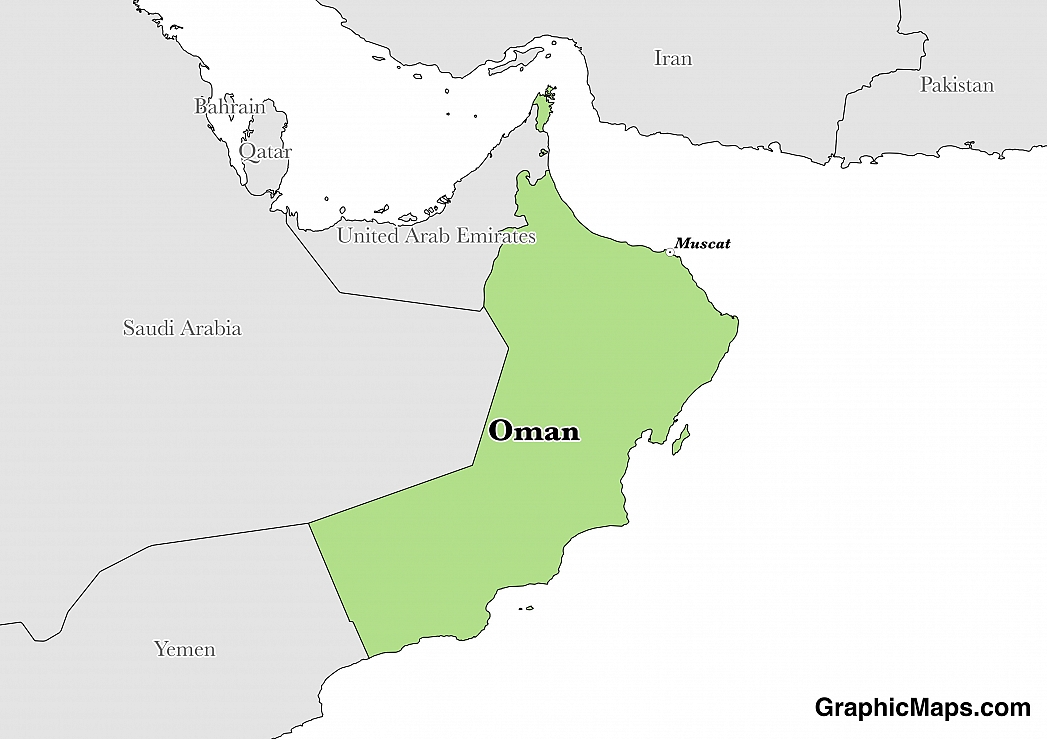Where is Oman?
Located in the Middle East, Oman has a 1,561.00 km border with Saudi Arabia (658 km), UAE (609 km) and Yemen (294 km). It has a 2,092.00 km coastline. Oman and the United Arab Emirates signed a ratified a border agreement in 2003.
The capital of the Sultanate of Oman is Muscat. It is the largest Metropolitan city in the country as well as the largest city in Muscat Governorate. As the capital, Muscat is the administrative headquarters of the Omani government. It covers an area of 1,400 square miles, and it is divided into six provinces. Muscat is one of the alpha cities in the world, and its economy relies mostly on trade and porting, mainly because it is a port city. Muscat is home to major trading companies like Saud Bahwan Group and Zubair Automotive. It is also the headquarters of Petroleum Development Oman, which is the primary gas and oil exploration and production company in Oman.
Read more on Oman's CapitalOman is an Asian country covering 309,500.00 km2. This makes it the 70th largest country in the world and twice the size of Georgia slightly smaller than Kansas. Its geographic coordinates are 21 00 N, 57 00 E and Muscat is the capital city.
The name Oman is said to date back at least 2,000 years, although its true origins are mostly unknown.
Its ISO code is OM.
Geography
Oman has a mean elevation of 310 m above sea level.
It has a desert climate that is hot and humid along the coast. Its terrain mostly consists of desert with rugged mountains in the north and south.
Population
Oman has a population of 3,355,262 making it the 134th largest in the world. The majority of the population can be found in and around the Al Hagar Mountains.
Arabic is the official language. The major ethnic groups reported are Arab, Baluchi, and South Asian. The majority of the country identifies as Muslim.
The national and official language of Oman is Arabic. The sign language of the deaf community in the country is the Omani Sign Language. English is however spoken widely in the country, and it is accepted as a second language of Oman. Most business operations in Oman are conducted in English hence expatriates do not encounter much trouble when they move to the country. Most of the schools in the nation also teach English as a second language, and official notices and road signs are mostly in both English and Arabic. Other Semitic dialects such as Jibali and Balochi are also spoken in Oman, as well as Urdu, Hindu, French, and Swahili.
Read more on Oman's LanguagesThe dialing code for the country is 968.
Government
Oman is an independent country. The Portuguese were expelled from the country in 1650. Its constitution was last ratified in 1996.
The Sultanate of Oman occupies the southeastern coast of Arabia. Its neighbors are Saudi Arabia, the United Arab Emirates, Yemen, the Gulf of Oman, and the Arabian Sea. Oman covers an area of 119,500 square miles and, as per 2016, the population estimate for the nation was 4,424,762. The country is made up eleven governorates or regions which are divided into 60 provinces, locally known as wilayats. Oman is one of the few nations in the Arab world that maintains diplomatic relations with Iran. The state has a predominant Islam population, and non-Muslim residents in the country are mostly expatriates.
Read more on Oman's GovernmentEconomy
Factoring in Purchasing Power Parity, Oman's GDP is $173,000,000,000.00 (USD) with $43,700.00 (USD) per capita. This makes it the 69th largest economy and its citizens the 36th richest in the world. The currency of Oman is the Rial (OMR).
Its major export partners are China, the United Arab Emirates, and South Korea. Its main exports are petroleum, reexports, fish, metals, and textiles. Its major import partners are the United Arab Emirates, Japan, and India. Its major imports include machinery and transport equipment, manufactured goods, food, and livestock.
Flag
The national flag of the Sultanate of Oman is referred to as Alam e Uman in Arabic. It has three colors namely red, white, and green, and bears the national emblem of the country. The nation adopted the flag by a Royal Decree on December 17, 1970, after Sultan Qaboos ascended to the throne and changed the name of the country from Muscat and Oman to the Sultanate of Oman. There are three types of national flags in Oman, which are distinguished by proportion. The National Flag is 1:2, the ceremonial flag is 5:7, and the State Flag is 4:7. Other variants of the national flag of Oman include the Naval Ensign of Oman and the Standard of the Sultan of Oman.
Read more on Oman's FlagThis page was last modified on January 17th, 2018
More on Graphicmaps

Published on 2019-11-06
What is a Trade Embargo?

Published on 2019-11-04
Which Two Countries Used to Have the Same Flag?

Published on 2019-09-16
What Is the Only Two-Sided State Flag?

Published on 2019-09-16
Which Country Flag Looks Like the Texas Flag?

Published on 2019-08-29
Flags That Resemble the US Flag

Published on 2019-08-20
